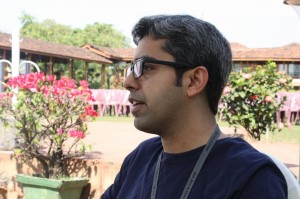Guest post by Kiran Nazish
Jaipur: It was all about sensations. It was about the exuberance of sounds, emotions, noise, feelings, aromas, color, joy and an irrepressible vivacity. There seemed to be thousands of people around; people who’d come from Bombay to Kolkatta to Pune to Goa to the US and London, all of them just readers and fans of literature. The sounds of laughter and loud, excited conversations drowning out the beeper-machine at the entrance. I walked inside, under a canopy of colorful, Rajastani-style umbrellas hanging from the sky, and into the big lawn where it all was going to happen.

Image copyright: Kiran Nazish.

M. Hanif featured on artist Rohit Chawla’s installation ‘Out of the Box’. Image copyright: Kiran Nazish.
There was no other place to be that morning. This was the biggest literature festival in the world and it looked like it. Built on a smaller festival that had started indigenously in the ‘pink city’ of Jaipur, the restyled Jaipur Literature Festival was launched by author William Dalrymple in 2006 as the first free literature festival in the world; also perhaps one of the most celebrated, judging by the increasing numbers of attendees. This year the festival broke records by bringing in 220,000 listeners across five days.

No wonder he’s so happy. Dalrymple swinging it while Reza Aslan looks on at a musical performance. Copyright: Kiran Nazish.
The smell of hot adrak (ginger) chai wafted soothingly through the fresh winter air of Jaipur, in the front lawn. Crowds of people were seated on chairs and on the ground, standing, some on heels, peeking over each others’ heads to catch a glimpse of the tremendous Nobel Prize winner and economist Amartya Sen, who gave the key note address at the festival opening. Sen’s keynote address outlined a seven-point vision for a better India, one that included a strong and secular right-wing party and that reserved more space for the arts and humanities in public life.

Adrak chai walas. Image copyright: Kiran Nazish.

Seats filled to capacity for Amartya Sen’s address. Image copyright: Kiran Nazish
The hundreds of thousands of attendees listened to about 260 panelists spread across 175 sessions. Luminaries like novelist Jhumpa Lahiri, celebrity novelist and film maker Xiaolu Guo, philosopher Michael Sandel and classicist Mary Beard engaged hundreds in every hall simultaneously.
The programs at the festival were diverse, with leitmotifs of discussions on a variety of different topics, from the US troop withdrawal in Afghanistan to CIA’s war on terror, from female voices and women’s rights to India’s disappearing languages. The intriguingly-titled session “Who will rule the world?” had Professor Rana Mitter of the University of Oxford laying out China’s incontrovertible candidacy for superpower status. Sessions like “Democracy Dialogues” that included the author of “Why India Votes,” discussed India’s current challenges and new developments as a democracy.

Jonathan Franzen’s session with author Chandrahas Choudhury. Image copyright: Kiran Nazish

The stunning Durbar Hall, full to capacity. Image copyright: Kiran Nazish.
This was the Jaipur Literature Festival’s biggest and most successful year to date, leaving participants with high expectations for next year’s event.
Kiran Nazish is a Pakistani journalist and academic, who currently teaches journalism at a university in India.
 Onwards with our exclusive coverage of the IV Goa Arts and Literary Festival!
Onwards with our exclusive coverage of the IV Goa Arts and Literary Festival! (FZ) Have you focused on any particular area of Karachi or written about it as a whole?
(FZ) Have you focused on any particular area of Karachi or written about it as a whole?